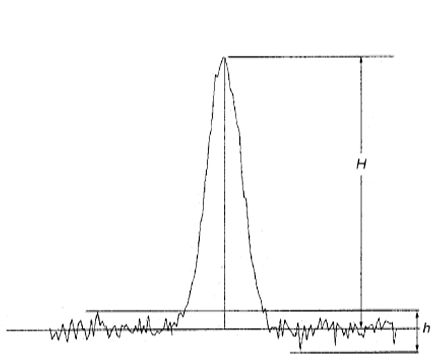Signal-to-noise calculation
OpenLab CDS has different options for the signal-to-noise calculation. You can choose both the algorithm and the noise range.
6 sigma or RMS method
The signal-to-noise is calculated using the formula:

Signal-to-noise ratio
Peak to peak or ASTM method
The signal-to-noise is calculated using the formula:
S/N = 2H/h
where | |
H |
Height of the peak corresponding to the component concerned in the chromatogram obtained with the prescribed reference solution. |
h |
Absolute value of the largest noise fluctuation from the baseline in a chromatogram obtained after injection or application of a blank and observed over a distance equal to twenty times the width at half- height of the peak in the chromatogram obtained with the prescribed reference solution, and situated equally around the place where this peak would be found. According to the definition of the European Pharmacopoeia, signal-to-noise is calculated against a blank reference signal and a noise calculated over the time range which contains the peak the S/N ratio is being calculated for. |
Noise range
Noise can be calculated against the following time regions and signals:
-
Automatically determined time region on a blank reference signal. The noise range that equals 20 times the peak width at half-height.
-
Automatically determined time region on the same signal or on a blank reference signal. The noise range that equals n times the peak width at half-height.
Fixed time region, on the same signal or on a blank reference signal
Time region relative to the peak start or end, on the same signal or on a blank reference signal
An automatically determined time region is calculated according to one of the following algorithms:
-
If the reference signal is not long enough
(EndTime - StartTime < N*W50)
-
StartTime = starttime of the signal, and
EndTime = endtime of the signal
N = number of times the width at half height of the peak (between 5 and 20, depending on the Pharmacopeia)
-
-
If the reference signal is long enough, but the peak is situated too close to the starttime
(tR-(N/2)*W50 < starttime of the reference signal)
-
StartTime = starttime (of reference signal), and
EndTime = StartTime + 20*W50
-
If the reference signal is long enough, but the peak is situated too close to the endtime
(tR+(N/2)*W50 > endtime of the reference signal)
-
EndTime = endtime (of the reference signal), and
StartTime = EndTime - N*W50
-
If the reference signal is long enough, and the peak is situated far enough away from starttime and endtime of the reference signal
(tR-(N/2)*W50 > starttime, tR+(N/2)*W50 < endtime)
-
StartTime = tR - (N/2)*W50, and
-
EndTime = tR + (N/2)*W50
-
where
tR is the retention time,
W50 is the peak width at half height, and
N is the number of times the width at half height of the peak (between 5 and 20, depending on the Pharmacopeia).
